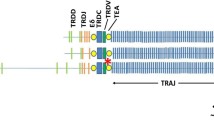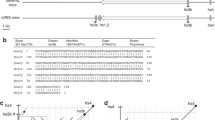Abstract
TheDR subregion of the human major histocompatibility complex from aDR4 haplotype includes the well-characterizedDR ga ,DR4 β DR(MT3) βandDR βψgenes. In addition, the region between theDR αand the proximalDR(MT3) βgenes contains several copies of conserved DR β -related sequences. These repeated elements, numbered II, III, and IV, include the DR β signal sequence and a region located further upstream. Further examination of these conserved sequences showed that DR β first intron sequences are present at the 3′ ends of these repeats. Progressively longer portions of the DR β first intron are conserved from repeat II to repeat IV, producing a gradient of conservation. The most complete repeat element of repeats II, III, and IV is associated with a loneβ1 exon (DR β1). Upon sequencing, (DR β1). was found to contain several deleterious mutations, indicating that it is nonfunctional. (DR β1). has accumulated a large number of replacement substitutions and mutations at positions which are invariant inβ1 domains from expressedDR βgenes: 77.8% of the nucleotide substitutions were replacement substitutions, and 41.5 % of the amino acids at invariant positions have been altered. Calculations based on these figures suggest thatDR β1 may have become inactive approximately 25 million years ago. There are, however, two histidine residues within a variable region which are unique toDR β1 and theDR4 βgene, suggesting that they represent a gene pair which probably evolved by duplication of a singleDR βchain gene.
Similar content being viewed by others
References
Breathnach, R. and Chambon, P.: Organization and expression of eucaryotic split genes coding for proteins.Annu. Rev. Biochem. 50: 349–383, 1981
Britten, R. J.: Rates of DNA sequence evolution differ between taxonomic groups.Science 231: 1393–1398, 1986
Denaro, M., Gustafsson, K., Larhammar, D., Steinmetz, M., Peterson, P A., and Rask, L.: Mouse MHC class II geneE β2 is closely related toE βand toHLA-DR β.Immunogenetics 21: 613–616, 1985
Efstratiadis, A., Posakony, J. W., Maniatis, T., Lawn, R. M., O'Connell, C. O., Spritz, R. Z., DeRiel, J. K., Forget, B. G., Sherman, W. M., Slightom, J. L., Blechl, A. E., Smithies, O., Baralle, F. E., Shoulders, C. C., and Proudfoot, N. J.: The structure and evolution of the humanβ-globin family.Cell 21: 653–668, 1980
Gustafsson,K., Wiman, K., Emmoth, E., Larhammar, D., Bohme, J., Hyldig-Nielsen, J. J., Ronne, H., Peterson, P. A., and Rask, L.: Mutations and selection in the generation of class II histocompatibility antigen polymorphism.EMBO J. 3: 1655–1661, 1984
Korman, A. J., Boss, J. M., Spies, T., Sorrentino, R., Okada, K., and Strominger, J. L.: Genetic complexity and expression of human class II histocompatibility antigens.Immunol. Rev. 85: 45–86, 1985
Kratzin, H., Yang, C. Y., Gotz, H., Pauly, E., Kolbel, S., Egert, G., Thinnes, F. P., Wernet, P., Altevogt, P., and Hilschmann, N.: Primärstruktur menschlicher Histokompatibilitätsantigene der Klasse II.Hoppe Seylers Z. Physiol. Biochem. 362: 1665–1669, 1981
Larhammar, D., Servenius, B., Rask, L., and Peterson, P A.: Characterization of an HLA DRβ pseudogene.Proc. Natl. Acad. Sci. U.S.A. 82: 1475–1479, 1985
Long, E. O., Wake, C. T., Gorski, J., and Mach, B.: Complete sequence of an HLA-DRβ chain deduced from a cDNA clone and identification of multiple nonallelic DRβ chain genes.EMBO J. 2: 389–394, 1983
Maniatis, T., Fritsch, E. F., and Sambrook, J.:Molecular Cloning: A Laboratory Manual. Cold Spring Harbor Laboratory, Cold Spring Harbor, New York, 1982
Maxam, A. M. and Gilbert,W.: Sequencing end-labeled DNA with base-specific chemical cleavage.Methods Enzymol. 65: 499–560, 1980
Meunier, H. F., Carson, S., Bodmer, W. F., and Trowsdale, J.: An isolatedβ 1 exon next to theDR αgene in theHLA-D region.Immunogenetics 23: 172–180, 1986
Shackelford, D. A. and Strominger, J. L.: Analysis of the oligosaccharides on the HLA-DR and DC1 B cell antigens.J. Immunol. 130: 274–282, 1983
Spies, T., Sorrentino, R., Boss, J. M., Okada, K., and Strominger, J. L.: Structural organization of the DR subregion of the human major histocompatibility complex.Proc. Natl. Acad. Sci. U.S.A. 82: 5165–5169, 1985
Author information
Authors and Affiliations
Rights and permissions
About this article
Cite this article
Haas, D.A., Boss, J.M., Strominger, J.L. et al. A highly divergedβ1 exon in theDR region of the human MHC: Sequence and evolutionary implications. Immunogenetics 25, 15–20 (1987). https://doi.org/10.1007/BF00768828
Received:
Revised:
Issue Date:
DOI: https://doi.org/10.1007/BF00768828




